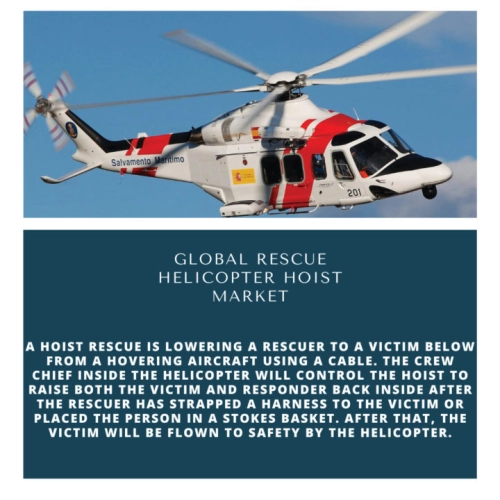
- Get in Touch with Us

Last Updated: Apr 25, 2025 | Study Period: 2022-2030
An emergency rescue instrument called a hoist is used to swiftly rescue or remove people from difficult or hazardous circumstances. In such cases, victims may be far away and difficult to access by roads, or they may be trapped by flood or fire. A hoist rescue is lowering a rescuer to a victim below from a hovering aircraft using a cable.

The crew chief inside the helicopter will control the hoist to raise both the victim and responder back inside after the rescuer has strapped a harness to the victim or placed the person in a stokes basket. After that, the victim will be flown to safety by the helicopter.
The global helicopter rescue hoist market accounted for $XX Billion in 2021 and is anticipated to reach $XX Billion by 2030, registering a CAGR of XX% from 2022 to 2030.
For increased safety, the Model 44318 design features an overload slip clutch and a load brake in the Weston type. It includes a fault code readout on the built-in test functionality, provides cable length readout in both feet and metres, and improves readout accuracy.
It also has a secondary shaft locking mechanism that satisfies Human External Cargo requirements, enhances the level wind system design for enhanced durability.
For military and civilian search and rescue helicopters fitted with heavy-duty hoists, the HS-16600 is a great backup system. The hoist, which is the lightest and smallest piece of equipment of its kind, can be used to increase the operational capacity of light single-engine helicopters and is portable in a carrying case.
| Sl no | Topic |
| 1 | Market Segmentation |
| 2 | Scope of the report |
| 3 | Abbreviations |
| 4 | Research Methodology |
| 5 | Executive Summary |
| 6 | Introduction |
| 7 | Insights from Industry stakeholders |
| 8 | Cost breakdown of Product by sub-components and average profit margin |
| 9 | Disruptive innovation in the Industry |
| 10 | Technology trends in the Industry |
| 11 | Consumer trends in the industry |
| 12 | Recent Production Milestones |
| 13 | Component Manufacturing in US, EU and China |
| 14 | COVID-19 impact on overall market |
| 15 | COVID-19 impact on Production of components |
| 16 | COVID-19 impact on Point of sale |
| 17 | Market Segmentation, Dynamics and Forecast by Geography, 2022-2030 |
| 18 | Market Segmentation, Dynamics and Forecast by Product Type, 2022-2030 |
| 19 | Market Segmentation, Dynamics and Forecast by Application, 2022-2030 |
| 20 | Market Segmentation, Dynamics and Forecast by End use, 2022-2030 |
| 21 | Product installation rate by OEM, 2022 |
| 22 | Incline/Decline in Average B-2-B selling price in past 5 years |
| 23 | Competition from substitute products |
| 24 | Gross margin and average profitability of suppliers |
| 25 | New product development in past 12 months |
| 26 | M&A in past 12 months |
| 27 | Growth strategy of leading players |
| 28 | Market share of vendors, 2022 |
| 29 | Company Profiles |
| 30 | Unmet needs and opportunity for new suppliers |
| 31 | Conclusion |
| 32 | Appendix |